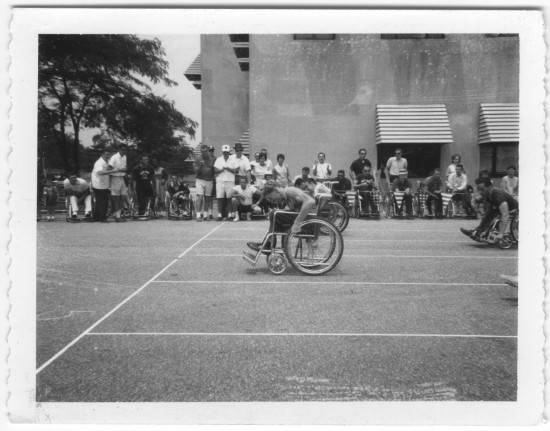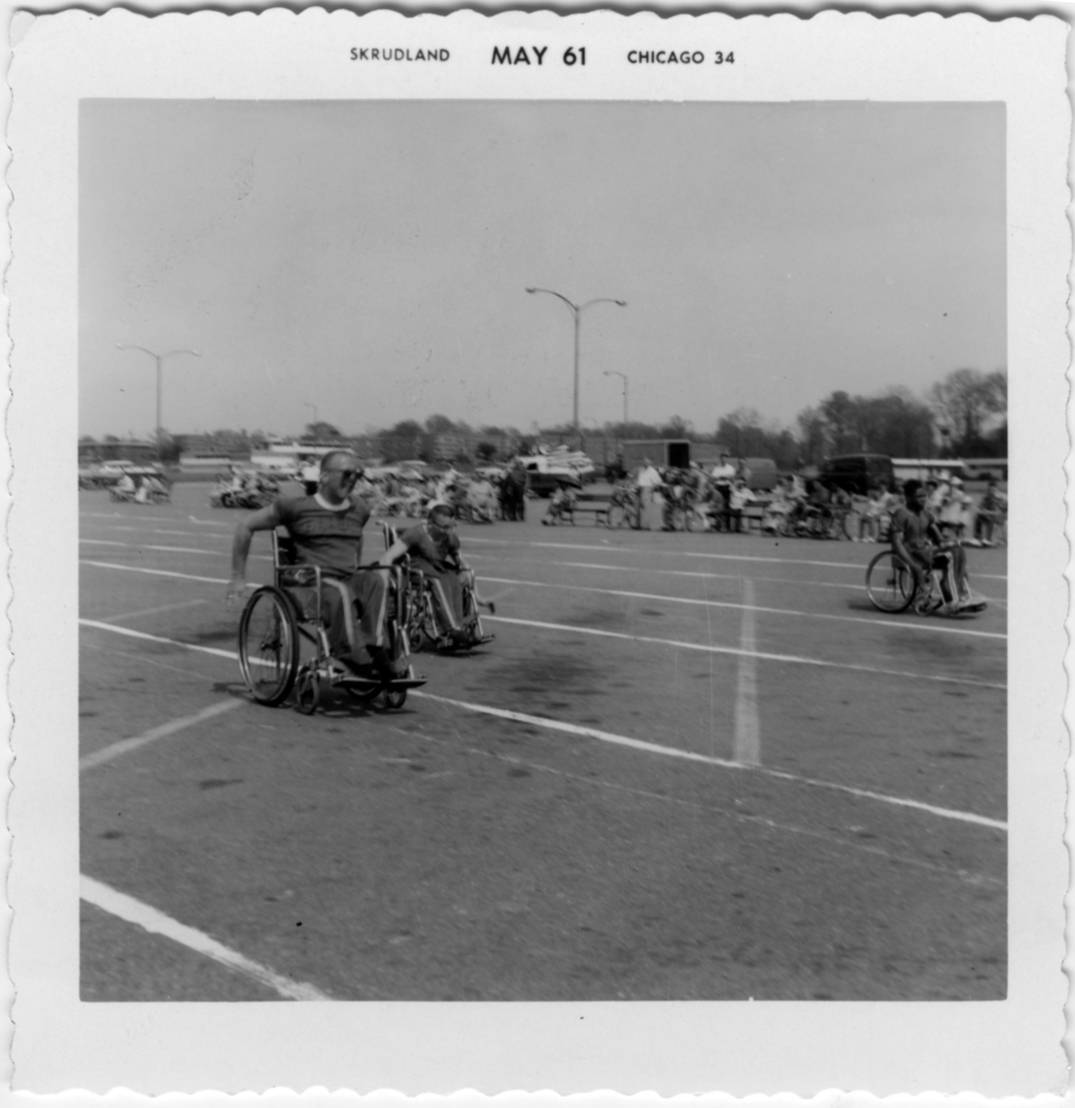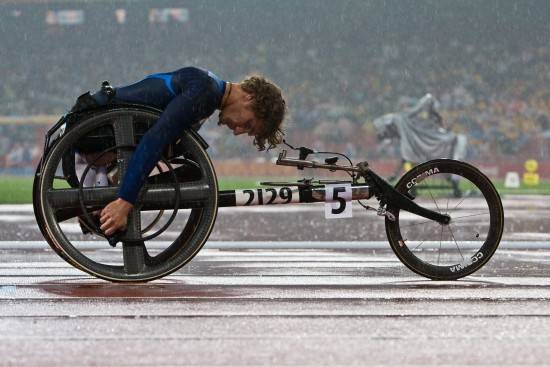
Buried on the edge of campus, nestled between a power plant and a nuclear research facility, is a building constructed from the straight lines and dirty windows of the 70s. A building that has doors that are rarely penetrated by walking, but houses one of the most elite athletic training centers in the country. Within its walls, athletes train without ever touching the ground — their lower limbs have been rendered useless due to disease, bullets, grenades, bone-snapping falls, car crashes and cycling mishaps — but their upper limbs look like they have been chiseled from stone.
This is the home of the University of Illinois wheelchair racing team.
The history of wheelchair racing in the United States is rife with references to athletes from the University of Illinois and from innovations coming from the corn-encompassed campus. If you spent any time living in this area before the turn of the century, the name Jean Driscoll is sure to prick up your ears in recognition. The most prolific female wheelchair racer in history, Jean won eight Boston Marathon titles, breaking the course record twice, and shagging five gold medals, three silver medals and four bronze medals in four Paralympic games (Seoul, Barcelona, Atlanta and Sydney) all while representing the University of Illinois (she even has a pavilion named after her off University Ave. in Urbana). However, there are a group of current University of Illinois racers poised to challenge even Jean’s greatness, and Jean’s accomplishments were aided by those that came before her.
I am one of them. It is for this history of racing greatness that I left my east coast roots to settle in middle America.
Not surprisingly, wheelchair racing has a relatively short history. Since the first ape-like mammal decided to forgo swinging on vines and take up jogging for their means of exercise, the small portion of the population to find themselves sans leg function suffered an evolving set of ends: eaten by lion, thrown of cliffs, carted around in wheelbarrows, locked in basements, and basically swept under the rug by societies who deemed them unfit or useless.
Then came the end of WWII and the return into society of a large number of young and incredibly able men, who happened to suffer spinal cord injuries or loss of limb while defending the world against megalomania. What do we do with all these young people in wheelchairs? There aren’t enough rugs!
Tim Nugent, a graduate student at the University of Illinois, took it upon himself to figure out what to do.
Nugent, a war vet himself, believed that people in wheelchairs should be granted access to the same quality of life as anyone else in society and that returning vets in wheelchairs should be able to use the newly formed G.I. Bill. He also believed that the best way for newly injured individuals to regain self-confidence, self-esteem and to develop healthy lifestyles was by playing sports. Beginning in 1948, Nugent turned the University of Illinois into the first accessible university in the country and began hosting wheelchair sports competitions for his student-athletes.

I would wager that the first ever wheelchair race took place in the dim lit halls of a rehab hospital when wheelchair-using patient one turned to wheelchair-using patient two and said, “You’re weak and have arms like toothpicks. Bet I can beat you to the cafeteria,” followed by a flurry of limbs and shrieks from Nurse Ratcheds (yes, there was trash talk right from the beginning).
Primitive organized wheelchair racing probably looked quite similar to its hallway fore fathers. Because of the popularity of cinder tracks (not conducive to wheeled vehicles) Athletes raced in the paved parking lots of strip malls and grocery stores. Until 1969 the standard events were the 40, 60 and 100 yard dashes, and athletes were required by the rules to use standard Everest and Jennings wheelchairs that weighed upwards of 50 lbs (see above — picture the wheelchairs you see in hospitals, then add 20 lbs).
The University of Illinois produced its first wheelchair racers in 1956 when it sent a team to the first annual National Wheelchair Games at Adelphi College in New York. Athletes from the university were also responsible for the first stage in the evolution of racing equipment in 1966, when they shortened the height of the seat back to create more freedom of motion, but the team did not reach its preeminent status until the 1980s when Marty Morse became the head coach.
Prior to Morse taking over the track and field program in 1983, it was rare to find wheelchair racers training and behaving like their able-bodied counterparts. They used equipment that was designed in someone’s garage as opposed to Trek’s R and D department, and adopted the “apres ski” atmosphere into a summer sport. Wheelchair sports were still widely seen as recreational.
It was Marty who turned wheelchair racers into full-bore athletes. With a background in exercise physiology and a voracious appetite for knowledge Marty perused the worlds of rowing, cycling, running, speed skating, and kayaking to glean useful chunks of information in developing his own training programs. He brought a science to the sport that had been lacking and he brought a professionalism that never existed. His athletes would show up every day prepared to practice and to races primed to win.
From 1988 to 2004 University of Illinois students and alumni coached by Marty accounted for 31 Paralympic medals (14 of the gold variety, and two of the bronze variety won by myself in 2004). He introduced the world of American wheelchair racing to the modern science of exercise physiology and even created a pushing technique that led to the mass manufacturing of a special glove worn by wheelchair racers (his technique was called the “para-backhand,” but don’t worry, you won’t need this information for the exam), the only mass produced glove of its kind.
By the time Marty handed the program over to his successor and former athlete, Adam Bleankey in 2005, wheelchair racers from all over the world were familiar with his name, and that of the University of Illinois.
A change of guard did nothing to hinder the University of Illinois’ success. At the Beijing Paralympic Games in 2008 U of I athletes accounted for 14 medals, exactly half of the medals earned in track and field by the US squad.
Currently, Bleankey coaches eight members of the US national team, including two current and four former world record holders, and is himself an elite wheelchair marathoner.
Adam, like those before him, works in an office in the pale corner of a gym packed with customized equipment in the aforementioned building wedged between a power plant and a nuclear research facility. It is the comic-book-perfect place for mutant athletes to evolve, and though his athletes may have accomplished super-human feats they are all a result of the atmosphere that has been created over decades of innovations and hours upon sweat-inducing hours of training.
(Editors Note: Joshua George grew up in Herndon, Virginia and came to the University of Illinois in 2002 on a partial athletics scholarship. Joshua was a two-time bronze medalist in Athens in 2004 and won a gold and silver medal at the Paralympics in Beijing in 2008. He was also a four-time world champion in 2006. Currently Joshua lives and trains in Champaign.)









